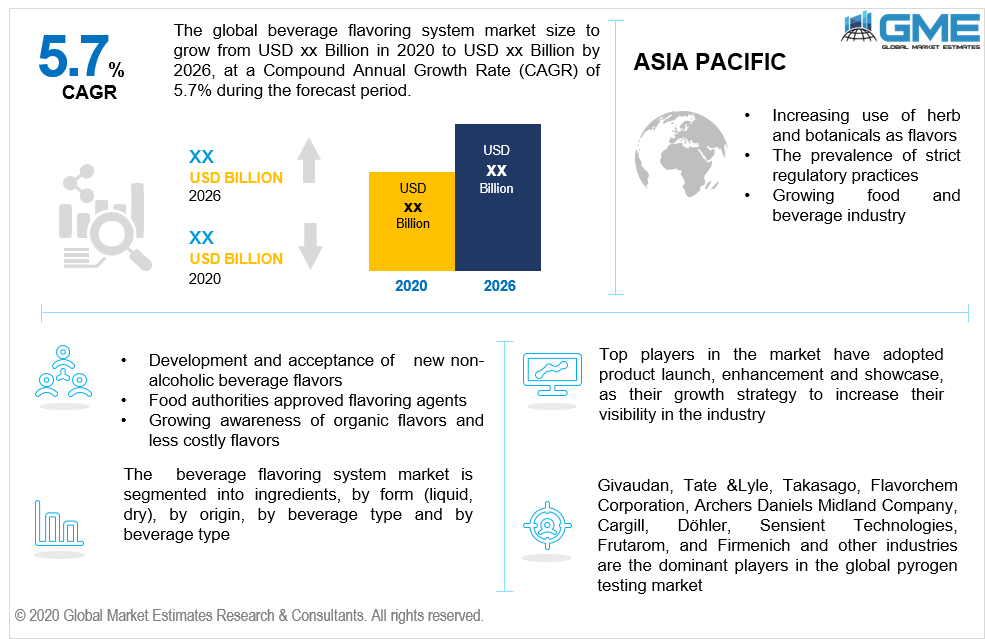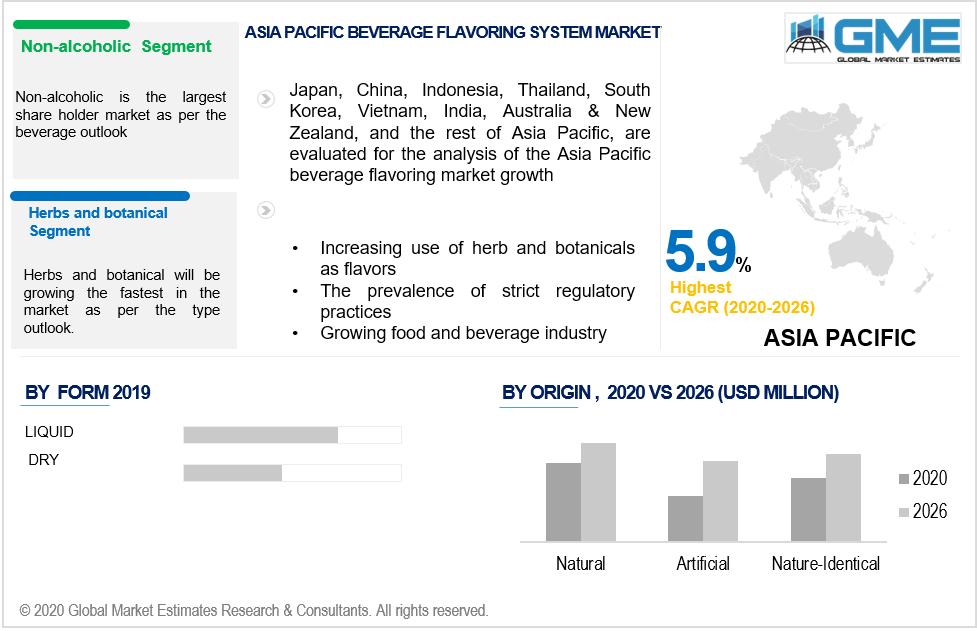
Global Beverage Flavoring Systems Market Share, Trends and Analysis - Forecasts to 2026 By Ingredients (Flavoring Agents, Flavor Carriers, Flavor Enhancers, Others), By Beverage Type (Alcoholic, Non-Alcoholic), By Type (Chocolates &Browns, Dairy, Herbs & Botanical, Fruits & Vegetables, Others), By Origin (Natural, Artificial, Nature-Identical), By Form (Liquid, Dry), By Region (North America, Asia-Pacific, Middle East and Africa, CSA, Europe), End-User Landscape and Company Market Share Analysis and Competitor Analysis
The beverage flavoring market is estimated to grow upwards during the forecast period. The beverage flavoring is done to enhance the beverage’s taste and also to refine the health advantages of beverages. The flavors are added to the beverages to enhance their stability, consistency, and also helps to replace bulky or costly ingredients. Alcoholic beverage flavoring is carried out to widen the customer base and is constantly developed to improve the taste. Citrus oils and herb tones are widely used flavoring agents in alcoholic beverages owing to their multifold benefits. The growing awareness of organic flavors, consumer high preferences for less costly and sweet drinks will lead to better opportunities for beverage flavoring in the market. As more manufacturers introduce Kosher and TTB certified flavors and all-natural extracts, the demand for the beverage flavoring goes up in the market domain. The growing consumer base in North America for natural flavors and development in technology to produce such high-end flavors leads to market expansion in the given timeframe.

Based on the ingredients, the market studies flavoring agents, carriers, and enhancers into being. Flavoring agent sub-division would have a large market chunk for this market. Flavoring agents form the largest segment of the food additives. Almost 1200 flavoring agents are implied in foods to cater to the development of flavor or reinvent the flavor fully. Since the flavoring agents are FSSAI regulated and also complements the beverages, the segment will dominate the other two divisions leading the market to grow positively in the given period.
Based on the beverage, the market includes non-alcoholic and alcoholic into being. The non-alcoholic beverages will be rapidly emerging in the market owing to manufacturers’ constant development of the flavoring agents and adoption of a gender-inclusive approach. As the consumption of non-alcoholic drinks rises globally owing to the inclination towards healthy adoption of habits and product diversification, it would also lead to better flavoring agents and carriers for the non-alcoholic beverages in the market.
Based on the type, the market considers chocolate &browns, fruits &vegetables, dairy, herbs & botanicals, and others. The herbs & botanical would have a huge market penetration. Using herbs and botanical as agents of flavors helps to amplify beverage flavors. They also enable to replace, artificial colors, sugar, and sodium thus addressing health issues. The rising Asian population in Western countries has also been discussed to add to the market demand for herbs and botanicals. Chocolate too will have a huge market share owing to their wide universal application and application in a variety of wines. Larget consumer base of chocolates will make the segment to remain a key market segment in the coming years.
Based on the origin, the market takes natural, nature identical and artificial into account. The natural segment would have a huge market chunk. The presence of key manufacturers like Natural Advantages for the development of kosher and natural flavors to cater to the beverage market will have a positive effect on market growth.
Based on the form, the market takes liquid and dry into being. The liquid segment would be trending upwards in the market. Liquid flavors are used extensively because of the ease of liquid flavors getting mixed easily to form a stable flavor. The trending encapsulation method is leading to higher growth levels for the segment in the market.

Based on the region, North America would be dominating the market space. rising demand for organic flavors, the presence of regulatory practices, and the development of new and advanced flavors would be enhancing the market scope in the region.
Key players operating in the market include Givaudan, Tate &Lyle, Takasago, Flavorchem Corporation, Archers Daniels Midland Company, Cargill, Dohler, Sensient Technologies, Frutarom, and Firmenich among others.
Please note: This is not an exhaustive list of companies profiled in the report.
In December 2020, Lagunitas launched a new line of alcohol-free IPNA.
In November 2020, Stone Brewing launched less gluten and low-calorie beer.
We value your investment and offer free customization with every report to fulfil your exact research needs.
The Global Beverage Flavoring Systems Market has been studied from the year 2017 till 2026. However, the CAGR provided in the report is from the year 2018 to 2026. The research methodology involved three stages: Desk research, Primary research, and Analysis & Output from the entire research process.

The desk research involved a robust background study which meant referring to paid and unpaid databases to understand the market dynamics; mapping contracts from press releases; identifying the key players in the market, studying their product portfolio, competition level, annual reports/SEC filings & investor presentations; and learning the demand and supply side analysis for the Beverage Flavoring Systems Market.

The primary research activity included telephonic conversations with more than 50 tier 1 industry consultants, distributors, and end-use product manufacturers.

Finally, based on the above thorough research process, an in-depth analysis was carried out considering the following aspects: market attractiveness, current & future market trends, market share analysis, SWOT analysis of the companies and customer analytics.

Tailor made solutions just for you
80% of our clients seek made-to-order reports. How do you want us to tailor yours?
OUR CLIENTS